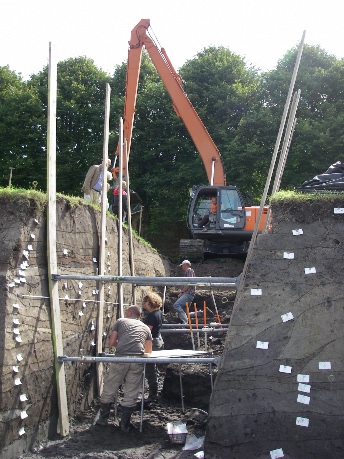Boek over de archeologische schatkamers van Friesland
Op donderdag 11 mei verschijnt het boek Friese terpen in doorsnede. Landschap, bewoning en exploitatie van archeoloog dr. Johan Nicolay van de Rijksuniversiteit Groningen en prof. dr. Gilles de Langen , bijzonder hoogleraar Archeologie van het Noord-Nederlandse terpen- en wierdenlandschap aan de Rijksuniversiteit Groningen, tevens werkzaam voor de provincie Fryslân. Het boek is het resultaat van zes jaar archeologisch onderzoek en vertelt de boeiende geschiedenis van het gebied aan de hand van archeologische doorsneden door zes Friese terpen, met speciale aandacht voor de bijzondere dynamiek tussen de terpbewoners en het kwelderlandschap waarin ze leefden.
Tekst: Marjolein te Winkel
In het boek worden de resultaten van het archeologisch onderzoek beschreven dat werd uitgevoerd tussen 2006 en 2012 op de terpen Anjum, Achlum, Jelsum, Firdgum, Oosterbeintum en Dronrijp. De opgravingen trokken vele belangstellenden en werden deels uitgevoerd door een vaste kern van enthousiaste vrijwilligers.
Archeologische schatkamers
Terpen zijn de archeologische schatkamers van Friesland en geven een unieke inkijk in het rijke verleden van het gebied, vanaf het moment dat de eerste kolonisten zich zo’n 2500 jaar geleden op de nog onbedijkte kwelder vestigden. Door het opwerpen van een woonheuvel die stapsgewijs met klei en afval werd opgehoogd, ontstonden de honderden terpen en wierden die nog steeds het Fries-Groningse landschap kenmerken.

Steilkantenonderzoek
Op de zes Friese terpen werd zogenaamd steilkantenonderzoek uitgevoerd, waarbij een langgerekte doorsnede (de ‘steilkant’) door de woonheuvel werd gemaakt. Zo werden de lagen waaruit elke terp is opgebouwd zichtbaar en konden allerlei vondsten worden verzameld. Deze lagen vertellen elk een deel van een bewoningsgeschiedenis die teruggaat tot enkele eeuwen voor het begin van de jaartelling. In het boek wordt de rijke geschiedenis van de zes terpen verteld, met bijzondere aandacht voor de relatie tussen mens en landschap in een periode dat men niet vocht tegen het water maar in harmonie leefde met het water.
Het onderzoek was een samenwerking tussen de provincie Fryslân en het Groninger Instituut voor Archeologie van de Rijksuniversiteit Groningen. Het boek is samengesteld en deels geschreven door Johan Nicolay (RUG) en Gilles de Langen (RUG/provincie Fryslân).
Meer informatie
Friese terpen in doorsnede. Landschap, bewoning en exploitatie (438 pagina’s, ISBN 9789082969122) wordt uitgegeven door de Vereniging voor Terpenonderzoek en is te bestellen via de website van de vereniging.
Meer nieuws
-
16 december 2025
Hoe AI mensen met taalstoornissen kan helpen hun spraak te vinden
-
18 november 2025
Een wifebeater? Hoe taal schadelijke ideeën versterkt
-
03 november 2025
Menopauze in perspectief: Hoe de media onze beleving beïnvloeden
